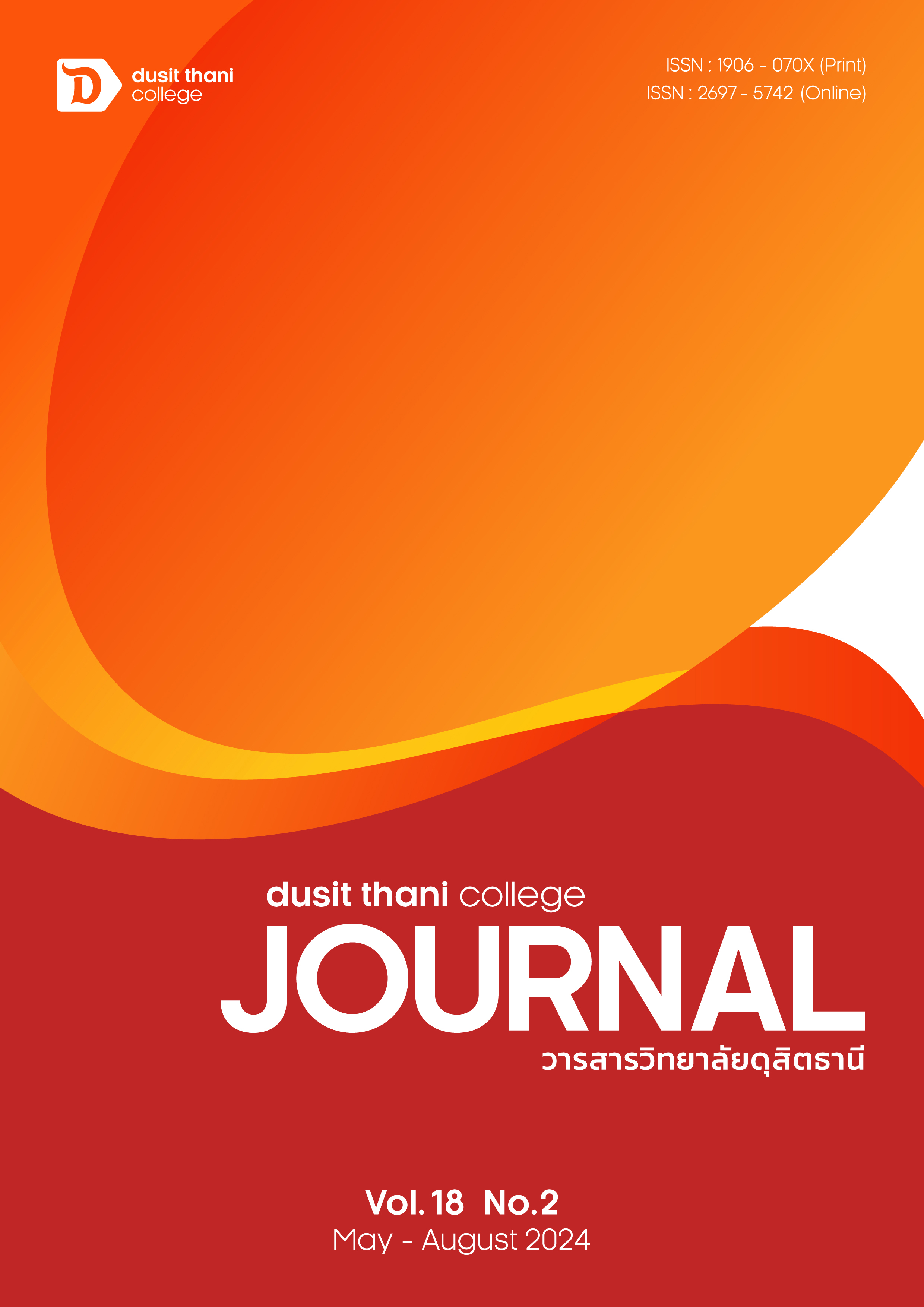Behavior and Marketing Mix Factors Affecting the Consumer’s Decision Making to Choose a “Chef’s Table” Restaurant in Bangkok
Main Article Content
Abstract
The research aims to explore the complex interplay of personal factors, behaviors, and marketing mix elements shaping the decision-making process of customers engaging in chef’s table experiences within the Bangkok area. This research is mixed-methods research, quantitative research, the sample comprises 400 individuals with chef’s table experience in Bangkok, who contributed by completing questionnaires as the primary data collection tool. Statistical analyses, including frequency, percentage, mean, standard deviation, and hypothesis testing using t-tests, ANOVA, and multiple regression analysis at a significance level of 0.05, were conducted for quantitative data analysis, qualitative insights were gleaned from interviews with 8 key informants, who are restaurant entrepreneurs or managers of chef’s table-style establishments in Bangkok.
The study's findings 1) demographic factor in term of gender, age, occupation and monthly income significantly influence customers' dining choices at chef's table restaurants, 2) behavior in term of, expenditure per visit, preferred visit days, the influencers guiding decision-making and the accessed sources of information significantly influence customers' dining choices at chef's table restaurants,
3) marketing mix were in term product, place, place, promotion, people, process and physical evidence related to the decision to choose a chef’s table restaurant in Bangkok, the coefficient of determination was 0.461 and the prediction equation was Y = 0.570 + 0.113X1 + 0.143X2 + 0.080X3 + 0.203X4 + 0.120X5 + 0.082X6 + 0.105X7 , 4) These insights have led to the development of a new framework for chef's table restaurant growth known as the "DOA Model," which focuses on three key areas: Diversity, Online presence, and Atmosphere.
Article Details

This work is licensed under a Creative Commons Attribution-NonCommercial-NoDerivatives 4.0 International License.
Article Screening Policy
- All research and academic articles to be published must be considered and screened by three peer reviews in the relevant field / article.
- All articles, texts, illustrations and tables published in the journal are the personal opinions of the authors. Editors don't always have to agree. And no responsibility whatsoever is the sole responsibility of the author.
- The articles to be published must never be published. Where did you first publish? And not in the consideration of other journals If the audit found that there has been a duplicate publication It is the sole responsibility of the author.
- Any article that the reader sees as being plagiarized or impersonated without reference. Or mislead the work of the author Please let the journal editor know it will be your greatest blessing.
References
Aminuddin, M., Don, M., and Shamsudin, M. F. (2020). Does Customer Satisfaction Matters ?. Journal of Undergraduate Social Science and Technology. 2(1), 1-6.
Amofah, O., Gyamf, I., and Tutu, C. O. (2016). The Influence of Service Marketing Mix on Customer Choice of Repeat Purchase of Restaurant in Kumasi, Ghana. European Journal of Business and Management. 8(11), 102-112.
Bai, L., Wang, M., Yang, Y., and Gong, S. (2019). Food safety in restaurants: The consumer perspective. International Journal of Hospitality Management. 77, 139- 146.
Bangkok Bank SME. (2021). Chef's Table, a career trending well during a time when Covid is still scary. Retrieved from https://www.bangkokbanksme.com/en/chefs-table-promising-career-during-covid
Buntadchan, K. (2021). Factors Affecting the Decision use Restaurant Services of Customer in Bangkok. Master Thesis. Bangkok: Ramkhamhaeng University.
Chunkajorn, P. (2021). Factors Affecting Consumer Decisions Restaurants Awarded Michelin Star in Thailand: Factors Affecting Consumer Decisions Restaurants Awarded Michelin Star in Thailand. Faculty of Humanities and Social Sciences Thepsatri Rajabhat University Journal. 12(2), 145–160.
Cochran, W.G. (1977). Sampling Techniques. (3rd Ed.). New York: John Wiley & Sons.
Hair, J.F., Black, W.C., Babin, B.J. and Anderson, R.E. (2010). Multivariate Data Analysis. (7th Ed.). New York: Pearson.
Kardes, F.K., Cronley, M., and Cline, T. (2011). Consumer Behaviour. Mason. South-Western: Cengage Learning.
KASIKORN Research Center. (2023). The growth of the value of the restaurant business in 2022-2023 among the challenges of cost and maintaining profits for entrepreneurs. Retrieved from https://www.kasikornresearch.com/th/analysis/k-econ/business/Pages/restaurant-z3352.aspx
Kotler, P., Armstrong, G., Denize, S., and Adam, S. (2012). Principles of marketing. (5th ed.). Sydney: Pearson Education.
Kotler, P., and Keller, K. L. (2012). Marketing Management. London: Pearson Education Limited.
Mahfud, T., Jono, P., and Lastarwati, B. (2019). Chef’s competency as a key element in food tourism success: A literature review. GeoJournal of Tourism and Geosites. 26(3), 1057-1071.
Mhlanga, O., and Tichaawa, D. T. (2016). What are the current factors affecting consumer selection criteria in formal full service restaurants in Port Elizabeth. African Journal of Hospitality, Tourism and Leisure. 5(2), 1-7.
Musikacharoen, C. (2022). Looking at the value of the restaurant business expanding this 2022-2023. Retrieved from https://www.efinancethai.com/LastestNews/LatestNewsMain.aspx?ref=A&id=bGVtZEU3WGNyekE9&security=KBANK
Narayanaswamy, R., and Heiens, R.A. (2022). Finding the optimal social media marketing mix to drive customer attraction and sales performance: an exploratory study. International Journal of Electronic Marketing and Retailing. 13(1), 65-82.
Saechurroji, S., and Martin, C. R. J. (2022). Marketing strategies in improving consumer purchase decisions Inadelia fashion shop suabaya. International Conference of Business and Social Sciences, 2(1), 699–707.
Samapundo, S., Climat, R., Xhaferi, R. & Devlieghere, F. (2015). Food safety knowledge, attitudes and practices of street food vendors and consumers in Port-au-Prince. Haiti. Food Control. 50, 457-466.
Zeithaml, V. A., and Bitner, M. J. (2003). Services marketing integrating customer focus across the firm. New York: Irwin McGraw-Hill.


